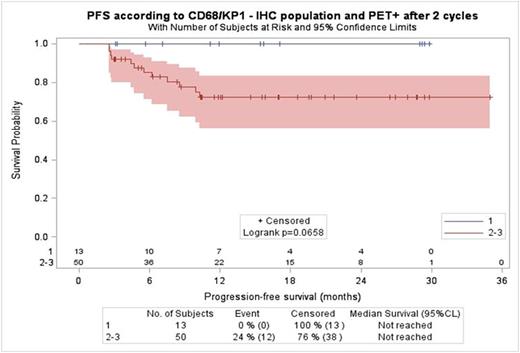Abstract
Although progression free survival and overall survival of patients with Hodgkin lymphoma (HL) has improved with modern treatment in the past 10 years, 10 % of patients will fail to conventional therapy and die of their lymphoma. The search of new prognostic factors for identifying these high risk patients at diagnosis of HL remains challenging in daily practice. The evaluation of the tumor microenvironnement was shown to help identifying a subset of patients treated with ABVD having a high risk of treatment failure (Tan KL et al, Blood 2012). PET positivity after 2 cycles of chemotherapy allows also identifying a subset of patients with poor outcome (Gallamini, JCO 2007) and PET-guided strategy were developed to improve the management of HL patients in order to either intensify treatment for high risk patients or deescalate treatment for sparing the others from toxicities. The aim of this study was therefore to evaluate the impact of baseline tumor microenvironnement in a large cohort of HL patients prospectively treated with upfront escalated BEACOPP in a randomized phase III clinical trial evaluating a PET-driven strategy (AHL 2011, NCT01358747) and to compare its prognostic value with other clinicopathological markers.
Material and Methods
Tumoral material was collected from May 2011 to May 2014 from HL patients prospectively enrolled in the AHL 2011 study. The AHL 2011 trial was designed to evaluate in 16-60 years old HL patients with Ann Arbor stage III, IV or high risk IIB, a de-escalade PET-driven strategy after 2 cycles of BEACOPPesc randomly compared to a standard treatment not driven by PET and delivering 6 cycles of BEACOPPesc. PET were centrally reviewed and interpreted according to Deauville criteria. As recently reported (Casasnovas, ASH 2015 Abs 577), the 2y-PFS was similar in the PET-driven (88%) and the standard arm (91%; p =0.79). The tumor microenvironnement was analyzed on formalin fixed paraffin embedded lymph node biopsy obtained for the diagnosis before treatment by morphological evaluation on standard staining (% polynuclear eosinophils, % lymphocytes, % plasmocytes, % histiocytes), and immunohistochemistry (IHC) scoring (score 0-1-2-3) for CD20, CD3, CD68-TAMs (tumor-associated macrophages) and CD163 and were centrally reviewed. Percentage of tumoral cells and EBV status were also analysed. In this analysis, the prognosis value of tissue markers expressions were compared to those of clinical and biological patient's characteristics, and PET results after 2 cycles of escalated BEACOPP.
Results
Six hundred fifty eight patients with available IHC data out of 823 enrolled in AHL2011 study were included in the analysis. With a median follow-up of 16.1 months, 2-year PFS was 89.4% (95% CI [86.2% ; 91.9%]) and 2-year OS 98.7% (95% CI [96.4% ; 99.5%]). In univariate analysis male gender, at least one extra-nodal involvement, B symptoms, Hemoglobin <10.5g/dL, Albumin <40g/L, IPS score≥ 3, positive PET2, immunophenotyping CD20 (2-3vs0-1) and CD163 (2-3 vs 1) were significantly associated with shorter PFS. In multivariate analysis positive PET2 was the only factor retaining an independent prognosis value and associated to a shorter PFS (p=.04, HR=2.5, CI95% (1.03-5.8)).
Among baseline patients characteristics, male gender, hemoglobin <10.5g/dL, IPS score ≥3, low % of lymphocytes, immunophenotyping CD3 (score ≥1), high CD20 (score ≥2), CD68 and CD163 expression were significantly associated with a higher risk of PET2 positivity. In multivariate analysis high CD68 expression (score 2-3 vs 1) was the only independent prognostic factor predicting PET2 positivity (p=.03, HR=2.4, CI95% (1.1-5.2)). 79% of PET2 positive patients have high CD68 expression and the combination of high CD68 expression and PET2 positivity identifies a subset of 50 patients (%) with a shorter 2y-PFS (72%) than PET2+/CD68low patients (2y-PFS=100%, p 0.066).
In conclusion, CD68 expression was confirmed to be an important prognostic marker in this large prospective cohort of patients treated with upfront escalated BEACOPP in a modern PET-guided strategy. Baseline high CD68 expression is associated to a higher risk of PET2 positivity and the combination of this microenvironment marker and PET2 results allowed identifying a population of patients with high risk of treatment failure.
Brice:Takeda Pharmaceuticals International Co.: Honoraria, Research Funding; Bristol Myers-Squibb: Honoraria; Seattle Genetics: Research Funding; Gilead: Honoraria; Roche: Honoraria. Casasnovas:BMS: Consultancy, Honoraria; Sanofi: Consultancy, Honoraria; Takeda: Consultancy, Honoraria; Abbvie: Consultancy, Honoraria; Gilead: Consultancy, Honoraria, Research Funding; ROCHE: Consultancy, Honoraria, Research Funding.
Author notes
Asterisk with author names denotes non-ASH members.



